Behind every great cup of coffee, a machine does a precise job; however, not all are designed equally. One of the most critical components of these marvelous machines is the boiler, responsible for brewing that rich espresso or frothing milk to perfection.
In this article, we go deeper into the world of coffee machine boilers, unraveling the secrets of the four existing types: Single-boiler, heat exchanger, dual-boiler, and thermoblock.
| Boiler type | Advantages | Disadvantages |
|---|---|---|
| Single-boiler | – Economical – Reliable | – Temperature management for milk frothing – Longer wait times for switching functions |
| Heat exchanger | – Simultaneous extraction and steaming – Suitable for milk-based drinks | – Challenges in precise temperature control |
| Dual-boiler | – Precise temperature control – Simultaneous extraction and steaming | – Higher initial cost – Increased maintenance costs |
| Thermoblock | – Requires regular maintenance | – Requires regular maintenance |
Single-boiler coffee machines
Single-boiler coffee machines are often the first choice for coffee enthusiasts looking to craft the perfect cup of coffee. These machines are highly regarded for their affordability and reliability, making them an excellent entry point into espresso coffee preparation.
How does a single boiler work?
When you want to brew coffee, the corresponding thermostat is activated and starts heating the water in the boiler. Once the water reaches the desired temperature for coffee extraction (typically around 90-96 degrees Celsius), the coffee machine is ready to use.
The hot water is pumped from the reservoir through the boiler and into the portafilter, where it comes into contact with the ground coffee to extract espresso. The water reaches the necessary temperature for brewing coffee while passing through the boiler.
If you need steam for milk frothing, the second thermostat is activated and heats the water in the boiler to a higher temperature to generate steam.

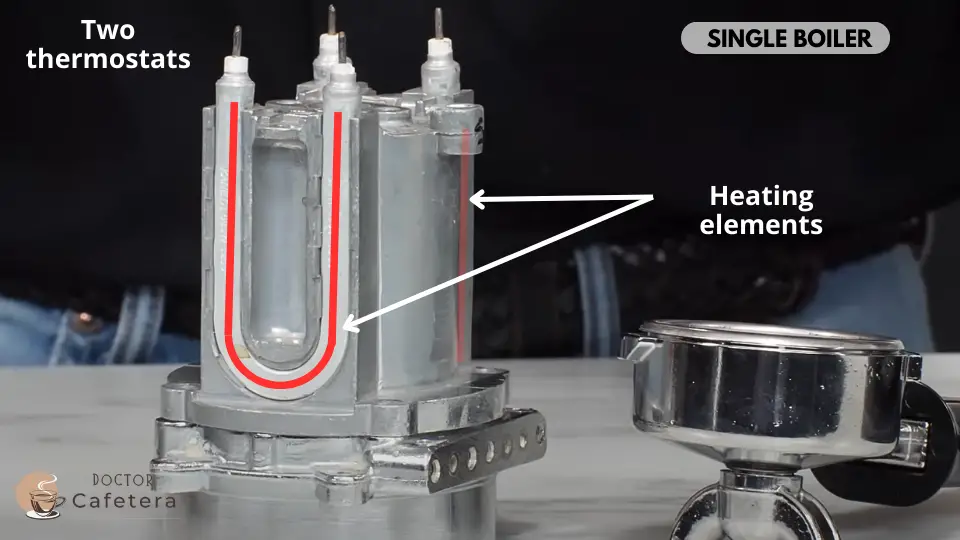
As can be seen in the above images, this device is composed of several fundamental elements:
- Boiler Chamber: This boiler chamber is the central part of the heating system. Water is stored and heated within this space.
- Heating Elements: On the exterior of the boiler, there are one or two heating elements. These heating elements are electrical resistances that generate heat when activated.
- Thermostats: Single-boiler coffee machines typically come equipped with two thermostats. One is used when brewing coffee, and the other is activated when steam is needed for frothing milk or other steam-related purposes.
✅ Affordability
One of the standout features of single boiler machines is their low cost. They are typically found in the lower price range of espresso machines, making them accessible to a wide range of consumers. They are ideal for those who want to experience the pleasure of brewing espresso at home without breaking the bank.
Examples of Single Boiler Coffee Machines:
| Coffee machine | Cost | Boiler type |
| Lelit Anna | $751.00 | Single Boiler |
| Gaggia Classic Pro | £429.00 | Single Boiler |
| Rancilio Silvia | $865.00 | Single Boiler |
✅ Reliability
Single-boiler espresso machines are renowned for their durability and straightforward design. With fewer components than their dual boiler or heat exchanger counterparts, these machines are less prone to technical issues and easier to maintain. This reliability is particularly appealing to those who prefer a hassle-free coffee experience.
❌ Coffee brewing vs. milk steaming
A unique feature of single-boiler espresso machines is their dual-function boiler. This boiler serves both for coffee brewing and milk steaming. However, this dual function comes with a drawback: temperature management.
When brewing espresso, the boiler heats the water to the ideal extraction temperature (198°F). But when the user switches to steaming milk for lattes or cappuccinos, the same boiler must reach a significantly higher temperature to produce steam.
This temperature disparity means a waiting period between extraction and steaming as the boiler cools down or heats up accordingly. This is especially noticeable if you want to brew an espresso after steaming milk, as the boiler needs to cool down, taking several minutes.
It’s important to consider this feature if you plan to prepare multiple milk-based beverages in succession. Single boiler machines are suitable for home users who don’t constantly switch between brewing and steaming, as their temperature limitations can result in longer wait times in a cafe setting.
Coffee machines with heat exchangers
Heat exchanger boilers are a more advanced option, perfect for coffee lovers experimenting with espresso crafting. These machines stand out for their ability to perform coffee extraction and milk steaming simultaneously.
Examples of heat exchanger coffee machines:
| Coffee machine | Cost | Boiler type |
| Lelit MaraX | $1,699.95 | Heat exchanger |
| Rocket Appartamento | £1,721.22 | Heat exchanger |
| Profitec Pro 500 | $1,949.00 | Heat exchanger |
How does a heat exchanger work?
The operation is based on heat transfer. The machine’s boiler contains water at a high temperature, typically around 250-260 degrees Fahrenheit, kept separate from the water used for brewing coffee.
The water for coffee flows through the heat exchanger, where it encounters the hot water from the boiler. As the water passes through this exchanger, it absorbs heat from the boiler and cools down to the ideal temperature for espresso extraction.
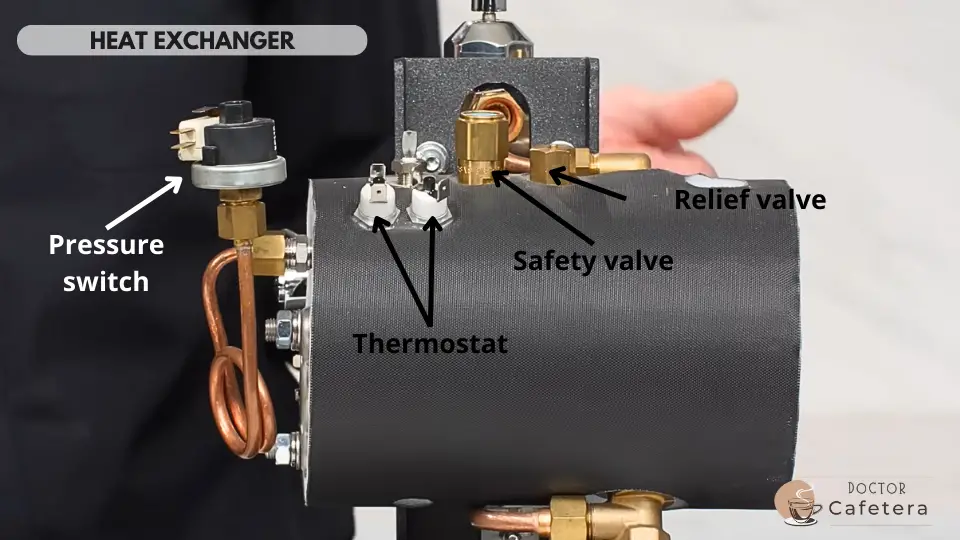
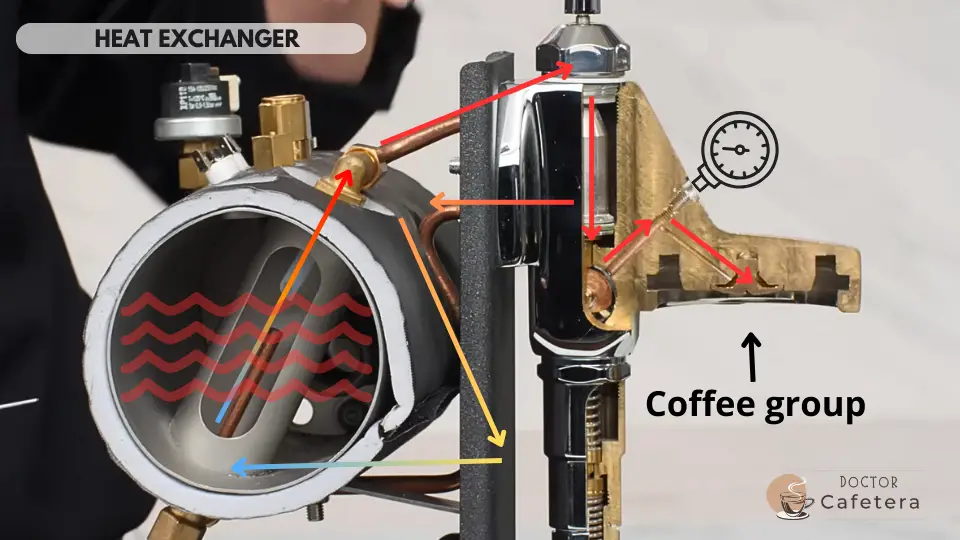
As you can see in the above images, this device consists of several essential elements:
- Pressure switch: Located on the exterior of the boiler, this device measures the pressure inside it. When the pressure reaches a specific value, the pressure switch activates or deactivates the heating element, thus controlling the water temperature.
- Safety valve: To ensure system safety, a safety valve is incorporated to release pressure when it reaches dangerous levels, preventing potential explosions due to excessive pressure buildup.
- Vacuum relief valve: During the machine’s cooling process, the heat exchanger can vent to atmospheric pressure, preventing vacuum buildup in the boiler.
- Thermostats: These switches serve as additional safety devices. If the temperature in the boiler becomes excessively high, high-limit switches shut off the heater to prevent overheating.
Note: It’s important to note that while temperature control with a pressure switch is effective at maintaining a relatively constant temperature in the boiler, it is not as precise as other temperature control methods, such as the PID system.
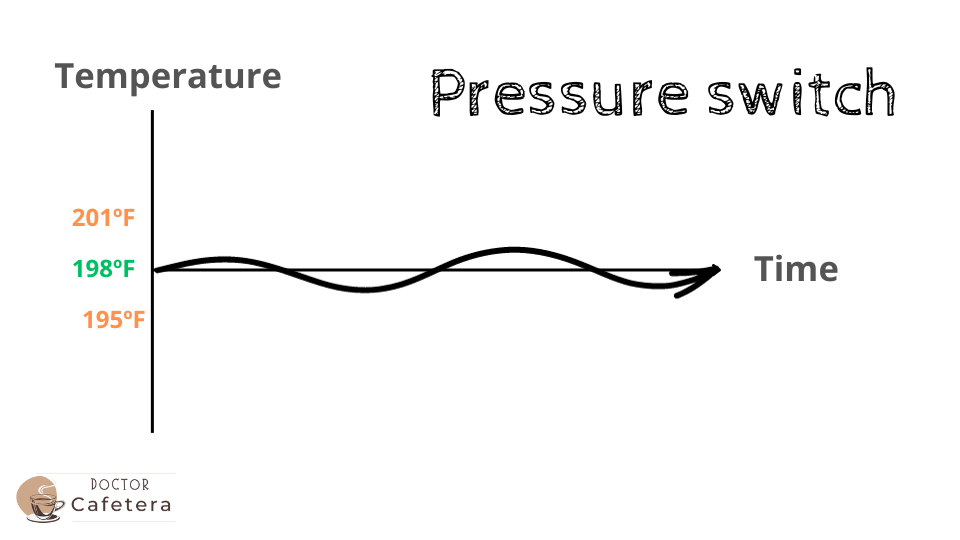
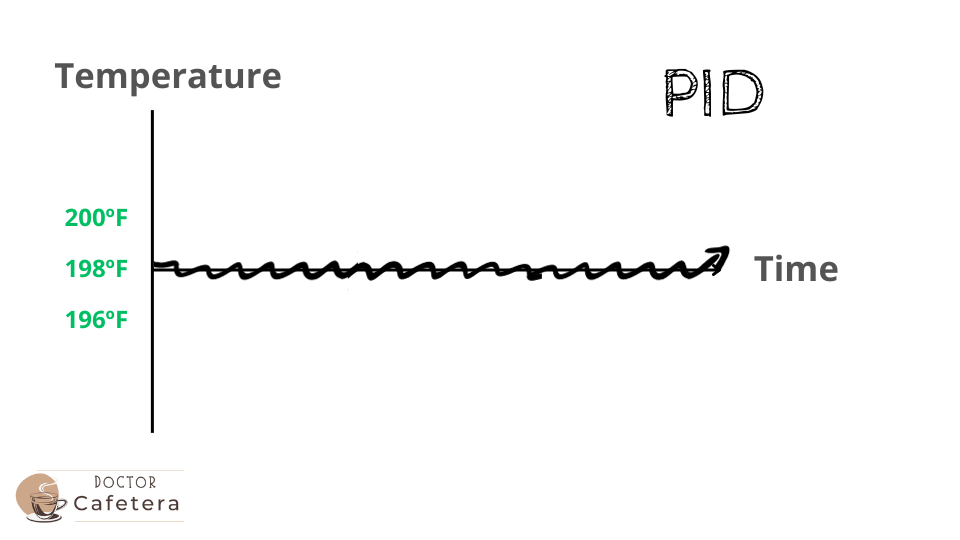
✅ Simultaneous extraction and steaming
Their ability to perform both functions simultaneously sets apart machines with a heat exchanger boiler. This is due to a clever design that harnesses the thermal energy from a single steam boiler and directs it to a secondary heat exchanger used for coffee extraction. This feature allows the user to brew espresso while frothing milk without waiting.
❌ Challenges in temperature control
Despite their simultaneous extraction and steaming capability, machines with heat exchanger boilers face precise water temperature control challenges. During extraction, water temperature tends to fluctuate slightly, impacting the consistency of the results. However, this factor also appeals to coffee enthusiasts who appreciate the complexity of flavors extracted at different temperatures.
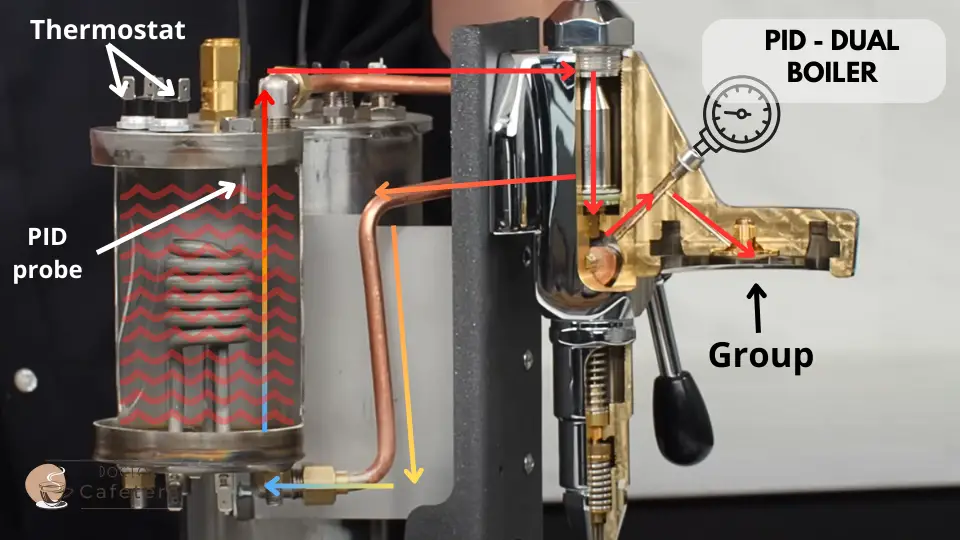

How does a dual boiler work?
As seen in the images above, a dual boiler operates with two separate boilers that serve different functions: coffee extraction and steaming.
Extraction Boiler: This boiler contains heated water for coffee extraction. It includes a thermostat or a PID controller that maintains the water temperature in the extraction boiler at a constant and precise level, typically around 194-203°F for espresso preparation.
When espresso extraction begins, the hot water is pumped from the extraction boiler through the ground coffee in the portafilter.
Steam Boiler: The steam boiler generates steam for frothing milk. It is also equipped with a thermostat or a PID controller to maintain a constant temperature but at a higher level, typically around 248-266°F to produce steam.
Water is heated in the steam boiler when steam is needed and converted into steam. The steam is directed to the steam wand and used to heat and froth milk to create beverages like lattes or cappuccinos.
Temperature Regulation: The extraction and steam boilers have PID temperature control systems to maintain the desired temperature levels. In the case of the extraction boiler, it is crucial to maintain a constant temperature for consistent espresso extraction.
Safety: Both boilers typically have safety measures, such as valves and high-limit thermostats, to prevent overheating and damage.
✅ Precision and performance
Their ability to provide precision in temperature control sets dual boiler machines apart. Most of these machines are equipped with PID (Proportional-Integral-Derivative) temperature control systems, allowing the user to adjust the temperature of both boilers with great accuracy.
This results in consistent and customizable coffee extractions, satisfying coffee connoisseurs looking to get the best out of each variety of beans.
✅ Ideal for coffee enthusiasts
Dual boiler machines are the ideal choice for those who appreciate the craft of coffee and want to experiment with different flavor profiles. With the ability to perform coffee extractions and milk frothing simultaneously, these machines are perfect for preparing multiple beverages quickly and without compromising quality.
Examples of dual boiler coffee machines:
| Coffee machine | Cost | Boiler type |
| Sage Dual Boiler | £1,142.36 | Dual boiler |
| Rancilio Silvia Pro X | $1,940.00 | Dual boiler |
❌ High cost
However, it’s important to mention that dual boiler machines are more expensive than other espresso machines. Additionally, due to their increased complexity, they may require more costly maintenance and repairs. It’s also important to note that the simultaneous operation of both boilers can result in higher energy consumption than single boiler machines.
Coffee machines with thermoblock
In the exciting world of coffee preparation, coffee machines with thermoblock stand out as an option that piques the interest of enthusiasts. These machines offer a unique experience in crafting this cherished beverage, blending efficiency and affordability into a single device.
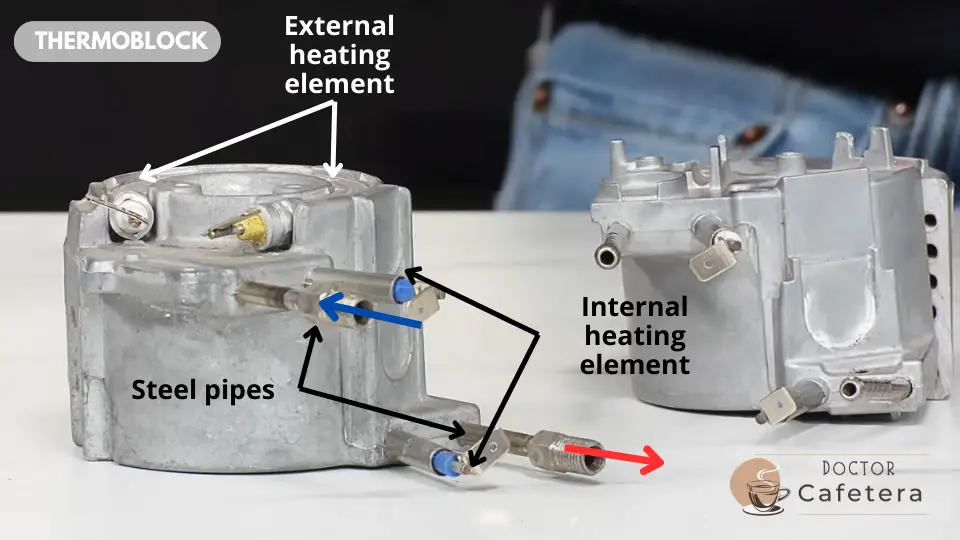
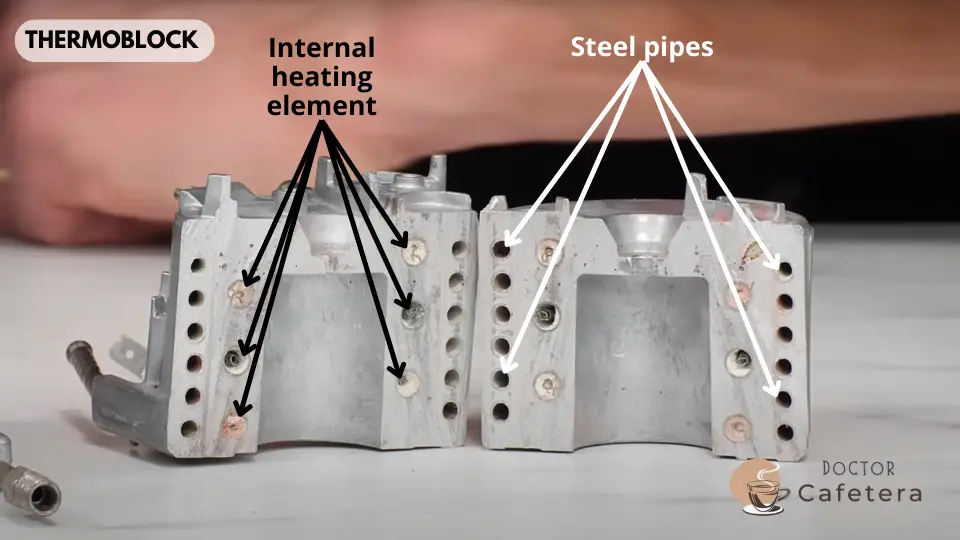
How does the thermoblock work?
The heating element inside the thermoblock is activated when the machine is turned on. This element begins to heat the aluminum block of the thermoblock and, consequently, the water flowing through it.
Cold water enters the thermoblock through the water inlet from the machine’s water reservoir, and as the water flows through the internal channels of the thermoblock, it gradually heats up.
The water temperature is controlled and maintained at a preset level, typically around 194-203°C, suitable for espresso extraction. This is achieved thanks to a thermostat attached to the thermoblock.
The hot water exits through the outlet pipe and is directed to the extraction group. In the extraction group, the water flows through the ground coffee to prepare the espresso.
As you can see in the images above, these are its main components:
- Solid block: The thermoblock is a solid component, typically made of aluminum or stainless steel, with internal channels for water flow.
- Heating element: The thermoblock contains a heating element, such as an electric resistance, responsible for heating the water.
- Water inlet: At the top of the thermoblock, a water inlet connects to the machine’s water supply.
- Hot Water Outlet: At the bottom of the thermoblock, there is an outlet through which hot water flows to the extraction group for coffee preparation.
✅ Efficiency for beginners
Thermoblock boilers, often found in entry-level espresso machines, provide an efficient solution for coffee lovers seeking an economical option.
These boilers typically consist of an aluminum block with stainless steel tubes threading through the block and an embedded heating element. Water heats up as it passes through the coil, providing hot water on demand. They are usually used with another heating element that heats the aluminum block to create a more efficient heating system.
Examples of coffee machines with thermoblock:
| Coffee machine | Cost | Boiler type |
| DeLonghi Dedica | $177.99 | Thermoblock |
| Sage Bambino Plus | £398.95 | Thermoblock |
❌ Maintenance and cleaning
Although thermoblock boilers are efficient, they have very small openings through which water spirals, making them susceptible to mineral buildup. Without preventive cleaning, these openings can become clogged with mineral deposits, negatively impacting the coffee quality and reducing the machine’s lifespan.
Conclusion
The choice of the right coffee machine largely depends on your preferences and needs.
- Single-boiler coffee machines offer affordability and reliability, ideal for those looking for a straightforward entry into espresso.
- Machines with heat exchange boilers allow for simultaneous extraction and steaming but may pose challenges in temperature control.
- On the other hand, dual-boiler coffee machines provide exceptional precision and performance, satisfying even the most discerning coffee enthusiasts, albeit at a higher cost.
- Finally, coffee machines with thermoblock stand out for their efficiency and affordability but require constant attention for maintenance and cleaning.
Whatever your choice, each type of coffee machine offers a unique experience in the quest for the perfect cup of coffee.

Thanks for the sensible critique. Me & my neighbor were just preparing to do a little research about this. We got a grab a book from our local library but I think I learned more clear from this post. I’m very glad to see such magnificent info being shared freely out there.